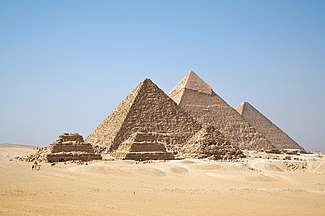Gerzeh culture
The Gerzeh culture, also called Naqada II, refers to the archaeological stage at Gerzeh (also Girza or Jirzah), a prehistoric Egyptian cemetery located along the west bank of the Nile. The necropolis is named after el-Girzeh, the nearby contemporary town in Egypt.[1] Gerzeh is situated only several miles due east of the oasis of Faiyum.[2]
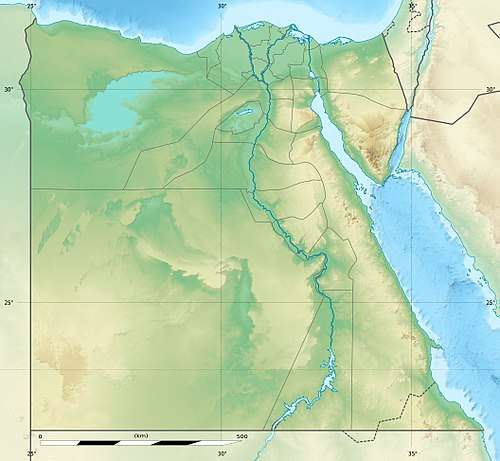 el-Girzeh Gerzeh culture/ Naqada II | |
| Dates | circa 3,500 BC — circa 3,200 BC |
|---|---|
| Major sites | al-Girza |
| Preceded by | Naqada I (Amratian) |
| Followed by | Naqada III |
The Gerzeh culture is a material culture identified by archaeologists. It is the second of three phases of the prehistoric Nagada cultures and so is also known as Naqada II. The Gerzeh culture was preceded by the Amratian culture ("Naqada I") and followed by the Naqada III ("protodynastic" or "Semainian culture").
Historical context
Sources differ on dating, some saying use of the culture distinguishes itself from the Amratian and begins circa 3500 BC lasting through circa 3200 BC.[3] Accordingly, some authorities place the onset of the Gerzeh coincident with the Amratian or Badari cultures, i.e. c.3800 BC to 3650 BC even though some Badarian artifacts, in fact, may date earlier. Nevertheless, because the Naqada sites were first divided by the British Egyptologist Flinders Petrie in 1894, into Amratian (after the cemetery near el-Amrah) and "Gerzean" (after the cemetery near Gerzeh) sub-periods, the original convention is used in this text.
The Gerzeh culture lasted through a period of time when the desertification of the Sahara had nearly reached its state seen during the late twentieth century.
The primary distinguishing feature between the earlier Amratian and the Gerzeh is the extra decorative effort exhibited in the pottery of the period. Artwork on Gerzeh ceramics features stylised animals and environment to a greater degree than the earlier Amratian artwork. Further, images of ostriches on the pottery artwork possibly indicate an inclination these early peoples may have felt to explore the Sahara desert.
 Comb with human image, Early Naqada II, 3500-3400 BCE, Brooklyn Museum.
Comb with human image, Early Naqada II, 3500-3400 BCE, Brooklyn Museum.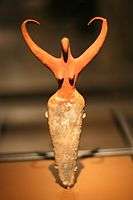 Figurine of a woman from the Gerzeh culture held at the Brooklyn Museum
Figurine of a woman from the Gerzeh culture held at the Brooklyn Museum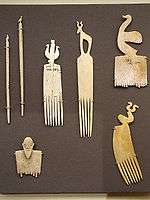 Ivory objects from the Naqada Culture.
Ivory objects from the Naqada Culture.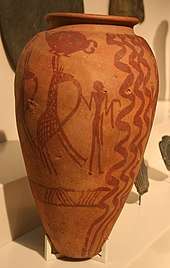 Paintings with symbols on Naqada II pottery. 3500-3200 BC.
Paintings with symbols on Naqada II pottery. 3500-3200 BC.
Reed boats
Pictures of ceremonial reed boats appear on some Naqada II jars, showing two male and two female figures standing aboard, the boat being equipped with oars and two cabins.[4]
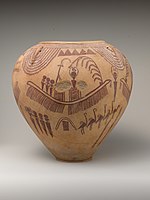 Jar, Late Naqada II, 3500-3300 BCE, Egypt
Jar, Late Naqada II, 3500-3300 BCE, Egypt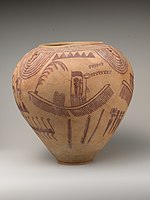 Jar, Late Naqada II, 3500-3300 BCE, Egypt
Jar, Late Naqada II, 3500-3300 BCE, Egypt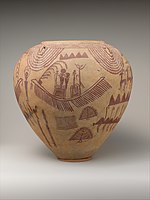 Jar, Late Naqada II, 3500-3300 BCE, Egypt
Jar, Late Naqada II, 3500-3300 BCE, Egypt
Contacts with Western and Central Asia
Distinctly foreign objects and art forms entered Egypt during this period, indicating contacts with several parts of Asia. Scientific analysis of ancient wine jars in Abydos has shown some there was some high-volume wine trade with the levant during this period.[7] Objects such as the Gebel el-Arak knife handle, which has patently Mesopotamian relief carvings on it, have been found in Egypt,[8] and the silver which appears in this period can only have been obtained from Asia Minor.[9]
Lapis lazuli trade, in the form of beads, from its only known prehistoric source – Badakhshan in northeastern Afghanistan – also reached ancient Gerzeh.[10] Other discovered grave goods are on display here.
Cylinder seals
It is generally thought that cylinder seals were introduced from Mesopotamia to Egypt during the Naqada II period.[11] Cylinder seals, some coming from Mesopotamia and Elam, and some made locally in Egypt following Mesopotamian designs in a stylized manner, have been discovered in the tombs of Upper Egypt dating to Naqada II and III, particularly in Hierakonpolis.[12][13] Mesopotamia cylinder seals have been found in the Gerzean context of Naqada II, in Naqada and Hiw, attesting to the expansion of the Jemdet Nasr culture as far as Egypt at the end of the 4th millennium BCE.[14][15]
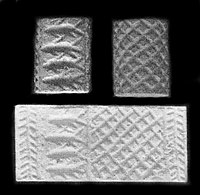
In Egypt, cylinder seals suddenly appear without local antecedents from around Naqada II c-d (3500-3300 BCE).[17] The designs are similar to those of Mesopotamia, where they were invented during the early 4th millennium BCE, during the Uruk period, as an evolutionary step from various accounting systems and seals going back as early as the 7th millennium BCE.[17] The earliest Egyptian cylinder seals are clearly similar to contemporary Uruk seals down to Naqada II-d (circa 3300 BCE), and may even have been manufactured by Mesopotamian crafstman, but they start to diverge from circa 3300 BCE to become more Egyptian in character.[17] Cylinder seals were made in Egypt as late as the Second Intermediate Period, but they were essentially replaced by scarabs from the time of the Middle Kingdom.[11]
Burials
Burial sites in Gerzeh have uncovered artifacts, such as cosmetic palettes, a bone harpoon, an ivory pot, stone vessels, and several meteoritic iron beads,[18] Technologies at Gerzeh also include fine ripple-flaked knives of exceptional workmanship. The meteoritic iron beads, discovered in two Gerzean graves by Egyptologist Wainwright in 1911,[19] are the earliest artifacts of iron known,[20] dating to around 3200 BC[21] (see also Iron Age).
One burial uncovered evidence of dismemberment in the form of decapitation.[22]
Oldest known Egyptian painted tomb
.jpg)
Discoveries at Nekhen include Tomb 100, the oldest known tomb with a mural painted on its plaster walls. The sepulchre is thought to date to the Gerzeh culture (c. 3500-3200 BC).
It is presumed that the mural shows religious scenes and images. It includes figures featured in Egyptian culture for three thousand years—a funerary procession of barques, presumably a goddess standing between two upright lionesses, a wheel of various horned quadrupeds, several examples of a staff that became associated with the deity of the earliest cattle culture and one being held up by a heavy-breasted goddess. Animals depicted include onagers or zebras, ibexes, ostriches, lionesses, impalas, gazelles, and cattle.
Several of the themes and designs visible in the Hierakonpolis frescoe can also be seen in other contemporary Egyptian works of art, such as the Gebel el-Arak Knife (c. 3500-3200 BCE), with the scene of the Master of animals, showing a man fighting against two lions, the individual fighting scenes or the boats.[23][24][25][26]
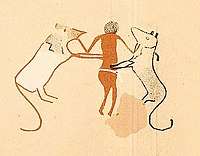
Master of animals.[26] 
Individual fighting scene 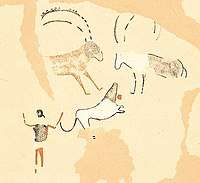
Hunting dog on a leash 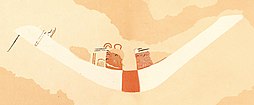
Boat
Proto-hieroglyphic symbols
Some symbols on Gerzeh pottery resemble traditional Egyptian hieroglyphs, which were contemporaneous with the proto-cuneiform script of Sumer. The figurine of a woman is a distinctive design considered characteristic of the culture.
The end of the Gerzeh culture is generally regarded as coinciding with the unification of Egypt, the Naqada III period.
Other artifacts
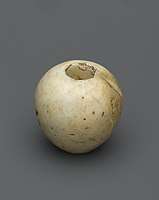 Egg-Shaped Mace Head 3500-3300 BCE Naqada II
Egg-Shaped Mace Head 3500-3300 BCE Naqada II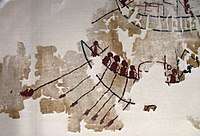 Painted linen (detail) from a grave in Gebelein, Naqada IIa-b (circa 3600 BCE). Museo Egizio, Turin.
Painted linen (detail) from a grave in Gebelein, Naqada IIa-b (circa 3600 BCE). Museo Egizio, Turin.
Notes
- Falling Rain Genomics, Inc. "Geographical information on Jirzah, Egypt". Retrieved 2008-03-22.
- University College London. "Map of the area between Meydum and Tarkhan". Digital Egypt for Universities. Retrieved 2008-03-22.
- Shaw, Ian, ed. (2000). The Oxford History of Ancient Egypt. Oxford University Press. p. 479. ISBN 0-19-815034-2.
- "Metmuseum". www.metmuseum.org.
- "Site officiel du musée du Louvre". cartelfr.louvre.fr.
- Cooper, Jerrol S. (1996). The Study of the Ancient Near East in the Twenty-first Century: The William Foxwell Albright Centennial Conference. Eisenbrauns. pp. 10–14. ISBN 9780931464966.
- Scarre, Chris; Fagan, Brian M. (2016). Ancient Civilizations. Routledge. p. 106. ISBN 9781317296089.
- Shaw, Ian. & Nicholson, Paul, The Dictionary of Ancient Egypt, (London: British Museum Press, 1995), p. 109.
- Redford, Donald B. Egypt, Canaan, and Israel in Ancient Times. (Princeton: University Press, 1992), p. 16.
- University College London. "Gerzeh, tomb 80". Digital Egypt for Universities. Retrieved 2008-03-22.
- Kantor, Helene J. (1952). "Further Evidence for Early Mesopotamian Relations with Egypt". Journal of Near Eastern Studies. 11 (4): 239. ISSN 0022-2968.
- Hartwig, Melinda K. (2014). A Companion to Ancient Egyptian Art. John Wiley & Sons. pp. 424–425. ISBN 9781444333503.
- Conference, William Foxwell Albright Centennial (1996). The Study of the Ancient Near East in the Twenty-first Century: The William Foxwell Albright Centennial Conference. Eisenbrauns. p. 15. ISBN 9780931464966.
- Isler, Martin (2001). Sticks, Stones, and Shadows: Building the Egyptian Pyramids. University of Oklahoma Press. p. 33. ISBN 978-0-8061-3342-3.
- Kantor, Helene J. (1952). "Further Evidence for Early Mesopotamian Relations with Egypt". Journal of Near Eastern Studies. 11 (4): 239–250. ISSN 0022-2968.
- Kantor, Helene J. (1952). "Further Evidence for Early Mesopotamian Relations with Egypt". Journal of Near Eastern Studies. 11 (4): 239–250. ISSN 0022-2968.
- Honoré, Emmanuelle. "Earliest Cylinder-Seal Glyptic in Egypt: From Greater Mesopotamia to Naqada". H. Hanna ed., Preprints of the International Conference on Heritage of Naqada and Qus Region, volume I.
- University College London. "Finds in Gerzeh tomb 67". Digital Egypt for Universities. Retrieved 2008-03-22.
- Great Pyramid of Giza Research Association. "The use of meteorites by the Ancient Egyptians". Retrieved 2008-03-22.
- "metalwork: Early history". Encyclopædia Britannica Online. Retrieved 2008-03-22.
- Jambon, Albert (2017). "Bronze Age iron: Meteoritic or not? A chemical strategy" (PDF). Journal of Archaeological Science. Elsevier BV. 88: 47–53. doi:10.1016/j.jas.2017.09.008. ISSN 0305-4403.
- University College London. "Gerzeh, tomb 67". Digital Egypt for Universities. Retrieved 2008-03-22.
- Shaw, Ian (2019). Ancient Egyptian Warfare: Tactics, Weaponry and Ideology of the Pharaohs. Open Road Media. p. 22. ISBN 978-1-5040-6059-2.
- Kemp, Barry J. (2007). Ancient Egypt: Anatomy of a Civilisation. Routledge. p. 94. ISBN 978-1-134-56389-0.
- Bestock, Laurel (2017). Violence and Power in Ancient Egypt: Image and Ideology before the New Kingdom. Routledge. p. 94. ISBN 978-1-134-85626-8.
- Hartwig, Melinda K. (2014). A Companion to Ancient Egyptian Art. John Wiley & Sons. p. 424. ISBN 978-1-118-32509-4.
- "The seal impressions, from various tombs, date even further back, to 3400 B.C. These dates challenge the commonly held belief that early logographs, pictographic symbols representing a specific place, object, or quantity, first evolved into more complex phonetic symbols in Mesopotamia." Mitchell, Larkin. "Earliest Egyptian Glyphs". Archaeology. Archaeological Institute of America. Retrieved 29 February 2012.
Bibliography
- Petrie/Wainwright/Mackay: The Labyrinth, Gerzeh and Mazghuneh, British School of Archaeology in Egypt XXI. London 1912
- Alice Stevenson: Gerzeh, a cemetery shortly before History (Egyptian sites series),London 2006, ISBN 0-9550256-5-6
External links
- Gerzeh (Girza). University College London, 2000
- Egypt, ancient. Encyclopædia Britannica, 2005
- Gerzeh Tomb 20
- Gerzeh Tomb 105
- Gerzeh Tomb 205
.jpg)
.jpg)

